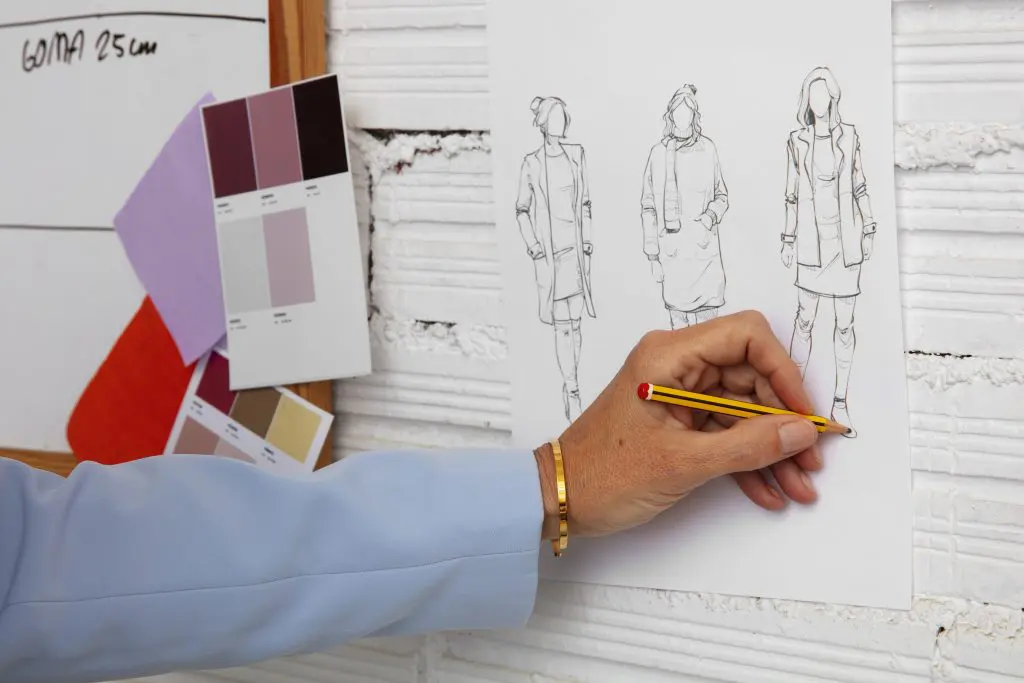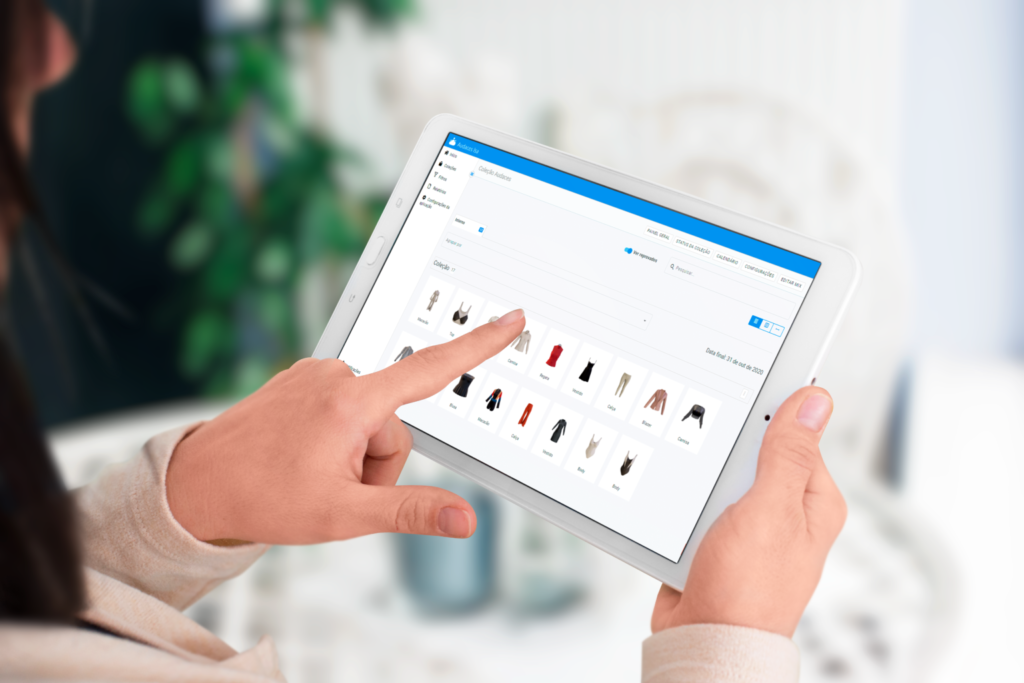Summary
- A textile flowchart outlines the production process for textile products
- Various types of flowcharts are available, so you can choose the one that suits your company best
- Explore managing each phase of your collection with Audaces360 multi-solution! Sign up for a free trial now.
A textile flowchart serves as a visual representation of the transformation process from raw materials to a finished textile product.
Its main purpose is to offer a clear and structured overview of the production process, enabling the identification of critical points and opportunities for enhancement.
Textile flowcharts come in various types, including general textile production, knitwear, technical fabrics, denim, and underwear.
If you’re interested in understanding how a textile flowchart can improve your manufacturing processes, keep reading!
Sumário
What is a textile flowchart?
A textile flowchart is a visual representation that illustrates the manufacturing process of textile products, encompassing items such as clothing, fabrics, knitwear, and various other textile goods.
Its primary function is to depict the sequence of steps involved in converting raw materials into a finished product.
Textile flowcharts come in a range of complexities, spanning from simple diagrams with only a few phases to more intricate representations that include multiple decision points.
The fundamental purpose of it is to offer a clear and systematic overview of the textile production process, facilitating the identification of critical junctures, bottlenecks, and potential opportunities for improvement.
Furthermore, textile flowcharts prove invaluable for purposes such as employee training, standardizing processes, and enhancing production process efficiency.
Learn more: Find out the finest apparel manufacturing softwares for your company

How to apply a textile flowchart to your production process?
A textile flowchart can be a versatile and adaptable tool for enhancing your production processes.
As you pinpoint opportunities for improvement, you can swiftly make necessary adjustments, ensuring that your production remains up-to-date and efficient.
To apply a textile flowchart to your production, follow these steps:
Step identification

Begin by identifying all the steps involved in your clothing production process, starting from the receipt of raw materials and concluding with the delivery of the final product.
Learn more: 4 top tips for a successful fashion collection launch
Flowchart design
Create a comprehensive flowchart using appropriate symbols to represent each step in the production process. Start at the process’s inception and follow a logical sequence, utilizing arrows to indicate the direction of flow.
Detailed operations
For each step, provide a thorough description of the specific operations performed. If a step involves activities like cutting, sewing and finishing, ensure these tasks are explicitly detailed within the flowchart.
Learn more: How does technology in fashion impact the textile industry?
Decision points
Identify any junctures in the process where decisions need to be made, and describe the available options. Utilize diverging arrows to illustrate different choices and their resulting consequences.
Include relevant information
Incorporate pertinent information such as the materials used at each step, the products obtained after each operation, and the flow of information and control throughout the process.
Review and validation
Collaborate with your team to review the initial flowchart design. Ensure that all aspects are accurately represented and make any necessary adjustments based on the team’s input.
Implementation
Share the finalized flowchart with all relevant employees involved in textile production. Ensure that everyone understands and follows the prescribed steps and operations outlined in the flowchart.
Monitoring and optimization
Continuously monitor the production process using the flowchart as a reference.
Identify opportunities for improvement and assess whether the process is being executed correctly.
Evaluate its effectiveness in terms of efficiency and product quality.
Learn more: Learn what textile processing is and how it adds value to your production
Textile flowchart examples

Textile flowcharts are highly adaptable to individual company needs and specific production processes.
However, here are some examples of textile flowcharts commonly used in the industry:
General textile production flowchart
This type of flowchart comprehensively covers all stages of textile production, from the acquisition of raw materials to the creation of the finished product.
It may encompass steps such as raw material preparation, spinning, weaving, dyeing, finishing, cutting, sewing, quality control, and packaging.
Knitwear production flowchart
Designed specifically for the production of knitwear, such as t-shirts, blouses, and sweaters, this flowchart includes steps such as yarn preparation, mesh weaving, dyeing, printing, cutting, sewing, finishing, and packaging.
Technical fabric production flowchart
Focusing on the manufacturing of technical fabrics utilized in industries like automotive, aerospace, sports, or medicine, this flowchart outlines steps related to fabric production, including specialized processes tailored to these specific applications.
Denim production flowchart
Tailored to the production of denim or jeans fabric, this flowchart encompasses steps such as yarn preparation, denim weaving, indigo dyeing, washing, cutting, sewing, finishing, quality control, and packaging.
Underwear production flowchart
Targeted at the production of underwear items like panties, briefs, and bras, this flowchart includes steps such as the preparation of stretch fabrics, specialized cutting, sewing, the application of elastics, finishing, quality control, and packaging.
Types of flowcharts in fashion manufacturing
In the realm of fashion manufacturing, various types of flowcharts can be employed to address specific needs and aspects of textile production.
These flowcharts can be customized to suit each company’s unique requirements.
In addition to the textile flowchart, several other pertinent examples include:
Textile chain flowchart

This comprehensive flowchart encompasses all stages of the textile chain, spanning from the acquisition of raw materials to the distribution of the final product.
It includes crucial steps such as fiber cultivation or manufacturing, spinning, weaving, dyeing, cutting, sewing, finishing, packaging, and transportation.
The textile chain flowchart provides an extensive view of the entire process, facilitating the identification of improvement opportunities at each stage.
Fabric marking flowchart
Specific for the fabric marking stage, this flowchart focuses on the essential steps related to fabric preparation and marking.
Key components of this flowchart encompass fabric preparation, template arrangement, marking procedures, and the execution of precise cuts.
By minimizing material waste and enhancing the efficient utilization of fabric resources, this flowchart contributes to cost reduction and efficient resource utilization.
Flowchart for manufacturing control
This flowchart focuses on activities related to quality control and clothing production.
It encompasses critical tasks such as inspecting raw materials, verifying measurements and standards, monitoring the sewing process, conducting final product evaluations, packaging, and managing shipping.
The manufacturing control flowchart establishes clear processes to ensure product quality and compliance with industry standards.
Benefits of implementing a textile flowchart in your company
Integrating a flowchart into your textile company can yield several advantages, including providing a comprehensive process overview.
Additionally, it aids in pinpointing bottlenecks and areas for enhancement, standardizing processes, facilitating employee training, enhancing internal communication, establishing clear responsibilities, and ensuring the final product’s quality.
These advantages collectively enhance operational efficiency, reduce costs, and elevate customer satisfaction levels. Explore further benefits of employing a textile flowchart below:
Comprehensive workflow visualization
The flowchart serves as a visual depiction of the textile production process, providing your team with a holistic understanding of the workflow.
This, in turn, facilitates the identification of individual steps and the interactions among various departments within the company.
Bottleneck and improvement identification

Flowcharts enable the identification of areas within the process where delays, resource wastage, or unnecessary rework may occur.
Armed with this insight, you can take proactive measures to optimize operations and enhance overall efficiency.
Process standardization
It defines the correct sequence of steps and their respective execution methods, thereby ensuring the consistent quality of the final product.
This standardization becomes especially vital for companies handling large production volumes, as it effectively mitigates errors and minimizes the need for rework.
Employee training
It provides a visual roadmap of the process steps, empowering employees to comprehend their roles and perform their tasks accurately.
Additionally, flowcharts serve as valuable references, aiding employees in acquainting themselves with the process and recognizing the significance of their contributions within the broader context.
Enhanced internal communication
With a visual representation of the process readily available, internal communication becomes more effective. Team members can easily share information, engage in collaborative problem-solving, and collectively arrive at solutions.
This shared understanding of the workflow contributes to improved operational efficiency and a reduction in misunderstandings among stakeholders.
Learn more: Discover how immersive fashion can benefit your apparel business
Identification of responsibilities
The utilization of a flowchart serves to elucidate the delineation of responsibilities and interactions among various departments or functions within the company.
This proactive approach helps to prevent gaps or overloading of roles, promoting a clear and equitable distribution of tasks while fostering improved coordination between teams.
Improvements in product quality
Through the identification and rectification of issues within the production flow, a flowchart plays a pivotal role in elevating the quality of the final product.
The standardization of processes, pinpointing bottlenecks, and the optimization of workflows collectively reduce errors, minimize the need for rework, and curtail wastage, resulting in a superior end product.
Enhance real-time visibility in your textile flowchart with Audaces Isa

Our suite of Audaces technologies offers a comprehensive range of tools and benefits designed to streamline the management of your fashion collections.
Among these powerful tools, Audaces Isa stands out as a key solution, enabling real-time monitoring of your product development processes.
Audaces Isa
Audaces Isa is a cutting-edge tool meticulously crafted to aid your teams in efficient collection management.
This solution reduces the time required to launch a new collection by more than 30%.
Audaces Isa ensures that all areas of your operation stay focused on their respective processes, resulting in a remarkable boost in overall efficiency for your company.
With our software you can:
- Create a centralized hub for collaborative work
- Safeguard your invaluable product files securely in the cloud
- Access your data online from any location, at any time, even via your mobile device
- Generate dynamic and complete reports to facilitate data-driven decision-making processes
- And much more!
Discover the transformative potential of Fashion PLM, learn how it operates, and uncover the myriad ways in which your clothing company can benefit!
Download our e-book for free and embark on a journey to optimize your fashion production processes:
FAQ
A textile flowchart is a visual representation of how textile products like clothing, fabrics, and knitwear are manufactured.
Apply it by identifying steps, designing the flowchart, specifying operations, making decisions, including data, reviewing, validating, implementing, and optimizing.
Types include textile chain, fabric fitting, and manufacturing control flowcharts.










